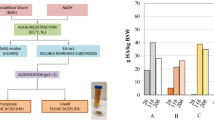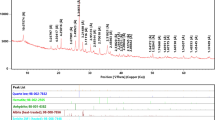Abstract
The biologic treatment of the dewatering effluent from thermally treated sludge is difficult due to the high concentration of refractory humic substances. On the other hand, humic substances are an important source of organic fertilizer. In this study, a novel process using ferric coagulant was developed to recover humic substances from dewatering effluent for use as an organic fertilizer. When ferric coagulant was applied to raw dewatering effluent, up to 70% of humic substances were enmeshed by hydrolyzed ferric ions at an optimum pH of 4.5. The proper mass ratio of iron ions to humic substances was 0.6. In the recovered material, humic substances accounted for 24.2% of the total dry solids, and the amount of phosphorus (equivalent phosphorus pentoxide) was 6.2%. Heavy metals and other components all met the legal requirements for organic fertilizer. When the recovered material was applied to soybeans, the germination and growth of the seeds was significantly improved.
Similar content being viewed by others
References
Neyens E, Baeyens J. A review of thermal sludge pre-treatment processes to improve dewaterability. Journal of Hazardous Materials, 2003, 98(1–3): 51–67
Wang W, Luo Y, Qiao W. Possible solutions for sludge dewatering in China. Frontiers of Environmental Science & Engineering in China, 2010, 4(1): 102–107
Perez-Elvira S I, Fdz-Polanco M, Fdz-Polanco F. Increasing the performance of anaerobic digestion: Pilot scale experimental study for thermal hydrolysis of mixed sludge. Frontiers of Environmental Science and Engineering in China, 2010, 4(2): 135–141
Feng H J, Hu L F, Mahmood Q, Long Y, Shen D S. Study on biosorption of humic acid by activated sludge. Biochemical Engineering Journal, 2008, 39(3): 478–485
Wang L, Li A. Hydrothermal treatment coupled with mechanical expression at increased temperature for excess sludge dewatering: the dewatering performance and the characteristics of products. Water Research, 2015, 68: 291–303
Li H, Li Y, Zou S, Li C. Extracting humic acids from digested sludge by alkaline treatment and ultrafiltration. Journal of Material Cycles and Waste Management, 2014, 16(1): 93–100
Zhang L, Li A, Lu Y, Yan L, Zhong S, Deng C. Characterization and removal of dissolved organic matter (DOM) from landfill leachate rejected by nanofiltration. Waste Management (New York, N.Y.), 2009, 29(3): 1035–1040
Huo S, Xi B, Yu H, He L, Fan S, Liu H. Characteristics of dissolved organic matter (DOM) in leachate with different landfill ages. Journal of Environmental Sciences-China, 2008, 20(4): 492–498
Kurniawan T A, Lo W H. Removal of refractory compounds from stabilized landfill leachate using an integrated H2O2 oxidation and granular activated carbon (GAC) adsorption treatment. Water Research, 2009, 43(16): 4079–4091
Wang F, Smith D W, Gamal El-Din M. Aged raw landfill leachate: membrane fractionation, O3 only and O3/H2O2 oxidation, and molecular size distribution analysis. Water Research, 2006, 40(3): 463–474
Ayuso M, Moreno J L, Hernández T, Garcia C. Characterisation and evaluation of humic acids extracted from urban waste as liquid fertilisers. Journal of the Science of Food and Agriculture, 1997, 75 (4): 481–488
Kliaugait De, Yasadi K, Euverink G J, Bijmans M F M, Racys V. Electrochemical removal and recovery of humic-like substances from wastewater. Separation and Purification Technology, 2013, 108: 37–44
Yang Y, Li H, Li J. Variation in humic and fulvic acids during thermal sludge treatment assessed by size fractionation, elementary analysis and spectroscopic methods. Frontiers of Environmental Science & Engineering, 2014, 8(6): 854–862
Stumm W, Morgan J J. Aquatic Chemistry: Chemical Equilibria and Rates in Natural Waters. New York: Wiley, 1996
Kloster N, Brigante M, Zanini G, Avena M. Aggregation kinetics of humic acids in the presence of calcium ions. Colloids and Surfaces. A, Physicochemical and Engineering Aspects, 2013, 427: 76–82
Sun C, Yue Q, Gao B, Mu R, Liu Y J, Zhao Z, Yang W, Xu. Effect of pH and shear force on flocs characteristics for humic acid removal using polyferric aluminum chloride–organic polymer dual-coagulants. Desalination, 2011, 281: 243–247
International Humic Substance Society (IHSS). Isolation of humic substances. Available online athttp://www.humicsubstances.org/ isolation.html (accessed December 2, 2012)
Jung A V, Chanudet V, Ghanbaja J, Lartiges B S, Bersillon J L. Coagulation of humic substances and dissolved organic matter with a ferric salt: an electron energy loss spectroscopy investigation. Water Research, 2005, 39(16): 3849–3862
Wu Z, He M, Guo X, Zhou R. Removal of antimony (III) and antimony (V) from drinking water by ferric chloride coagulation: Competing ion effect and the mechanism analysis. Separation and Purification Technology, 2010, 76(2): 184–190
Tang H X, Stumm W. The coagulating behaviors of Fe (III) polymeric species—I. Preformed polymers by base addition. Water Research, 1987, 21(1): 115–121
Cathalifaud G, MossaMT W, Mazet M. Preformed ferric hydroxide flocs as adsorbents of humic substances. Water Science and Technology, 1993, 27(11): 55–60
Duan J, Niu A, Shi D,Wilson F, Graham N J D. Factors affecting the coagulation of seawater by ferric chloride. Desalination and Water Treatment, 2009, 11(1–3): 173–183
Cheng W P. Comparison of hydrolysis/coagulation behavior of polymeric and monomeric iron coagulants in humic acid solution. Chemosphere, 2002, 47(9): 963–969
Ministry of Agriculture of People’s Republic of China. Organic Fertilizer (NY525–2011). Beijing: China Standards Press, 2011 (in Chinese)
Ministry of Agriculture of People’s Republic of China. Water-Soluble Fertilizers Containing Humic-Acids (NY1106–2006). Beijing: China Standards Press, 2006 (in Chinese)
Author information
Authors and Affiliations
Corresponding author
Rights and permissions
About this article
Cite this article
Yang, Y., Li, H. Recovering humic substances from the dewatering effluent of thermally treated sludge and its performance as an organic fertilizer. Front. Environ. Sci. Eng. 10, 578–584 (2016). https://doi.org/10.1007/s11783-015-0827-5
Received:
Accepted:
Published:
Issue Date:
DOI: https://doi.org/10.1007/s11783-015-0827-5




